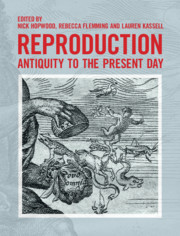Crossref Citations
This Book has been
cited by the following publications. This list is generated based on data provided by Crossref.
Lettow, Susanne
2015.
Population, race and gender: on the genealogy of the modern politics of reproduction.
Distinktion: Journal of Social Theory,
Vol. 16,
Issue. 3,
p.
267.
OLSZYNKO-GRYN, JESSE
and
ELLIS, PATRICK
2017.
‘A machine for recreating life’: an introduction to reproduction on film.
The British Journal for the History of Science,
Vol. 50,
Issue. 3,
p.
383.
Berthiaud, Emmanuelle
2020.
La santé maternelle et infantile (Europe, XVI e -XIX e siècles) : état des lieux historiographique et bibliographique.
Annales de démographie historique,
Vol. n° 139,
Issue. 1,
p.
27.
Müller-Wille, Staffan
2021.
Handbook of the Historiography of Biology.
p.
105.
Rupik, Gregory
2021.
Ateleological propagation in Goethe’s Metamorphosis of plants
.
History and Philosophy of the Life Sciences,
Vol. 43,
Issue. 1,
Wallingford, John B.
2021.
Aristotle, Buddhist scripture and embryology in ancient Mexico: building inclusion by re-thinking what counts as the history of developmental biology.
Development,
Vol. 148,
Issue. 3,
Kingstone, Helen
2021.
Generational identities: Historical and literary perspectives.
Social and Personality Psychology Compass,
Vol. 15,
Issue. 10,
Hsiung, Hansun
and
Serrano, Elena
2021.
Introduction: Epistemologies of the Match.
Isis,
Vol. 112,
Issue. 4,
p.
760.
Chadwick, Rachelle Joy
2022.
Visceral Acts: Gestationality as Feminist Figuration.
Signs: Journal of Women in Culture and Society,
Vol. 48,
Issue. 1,
p.
229.
Sebastiani, Silvia
2022.
Ce que les animaux font au genre.
Clio,
Donaghy, Paige
2022.
Wind eggs and false conceptions: thinking with formless births in seventeenth-century European natural philosophy.
Intellectual History Review,
Vol. 32,
Issue. 2,
p.
197.
Ray, Sara
2022.
From Monsters to Malformations: Anatomical Preparations as Objects of Evidence for a Developmental Paradigm of Embryology, 1770–1850.
Journal of the History of Biology,
Vol. 55,
Issue. 1,
p.
35.
Hopwood, Nick
2023.
A Sexless Universe: How Microbial Genetics Shaped the First History of Reproduction, François Jacob’s The Logic of Life.
HOPOS: The Journal of the International Society for the History of Philosophy of Science,
Vol. 13,
Issue. 2,
p.
511.
Cooley, Mackenzie
2023.
Horse racing: Unnatural selection in the renaissance.
History Compass,
Vol. 21,
Issue. 8,
Agiriano, Arantza Etxeberria
2023.
Jacob’s Understanding of Reproduction: Challenges from an Organismic Collaborative Framework.
HOPOS: The Journal of the International Society for the History of Philosophy of Science,
Vol. 13,
Issue. 2,
p.
535.
Downham Moore, Alison M
2023.
Race, class, caste, disability, sterilisation and hysterectomy.
Medical Humanities,
Vol. 49,
Issue. 1,
p.
27.
Hussey, Kristin D.
2023.
Timeless spaces: Field experiments in the physiological study of circadian rhythms, 1938–1963.
History and Philosophy of the Life Sciences,
Vol. 45,
Issue. 2,
Gutierrez, Jesús Alfredo Berdugo
Ammar, Omar
Plessis, Stefan Du
and
Maya, Walter Cardona
2023.
Mimicking Mother Nature in the Field of Human Reproduction?.
Revista Brasileira de Ginecologia e Obstetrícia / RBGO Gynecology and Obstetrics,
Vol. 45,
Issue. 03,
p.
159.
Romero de Pablos, Ana
and
Santesmases, María Jesús
2023.
Ontologías híbridas: materiales, culturas experimentales y género.
Dynamis,
Vol. 43,
Issue. 2,
p.
327.
Hilevych, Yuliya
and
Claes, Tinne
2023.
Peer-to-peer counselling and emotional guidance on infertility in Britain and Belgium (1970s–1980s).
Medical Humanities,
Vol. 49,
Issue. 2,
p.
214.





